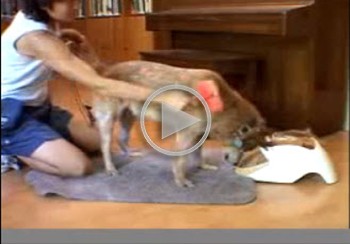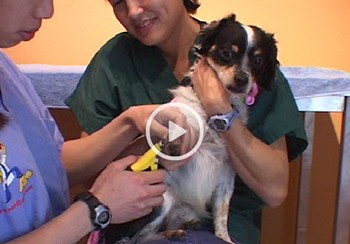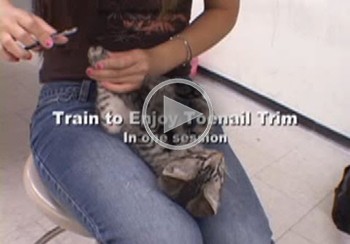
You finally mustered the nerve to carry out the task you’ve been dreading all week—a must because you’re having guests and you want Fido to look his best! Brush in one hand, nail clippers in the other, you hunt for Fido throughout the house. . “I got him. He’s over here!” shouts your spouse. The two of you conspire to hold the struggling Cocker Spaniel down to give a toenail trim and groom his mats out but after just seconds you both give up.
Many pet parents are afraid or unable to trim their dog or cat’s nails and some are even unable to brush their pets. You might think it’s not a big deal; however, these are essential pet care tasks that may need to be performed on a regular basis. Untrimmed or worn nails can snag on objects and tear as well as cause abnormal walking gait. They can even grow so long that they curve around back into the foot causing lameness and pain. Long nails can also cause damage to furniture and can scratch humans who are playing with their long-nailed pets. Brushing is also essential in pets with long-hair or thick coats in order to prevent matting, help decrease shedding, and prevent associated skin problems.
You might thing you can avoid the issue by sending your pet to the veterinary hospital or groomer to have these tasks done, but many pets are just as bad there and consequently the events are extremely stressful and can get worse with each visit.
Luckily it turns out that both dogs and cats can be trained to allow and even enjoy grooming and toenail trims. The trick is to pair the event with something positive and to train in systematic steps.
Training pets to love having their nails trimmed
For instance, to train a pet to tolerate toenail trim we want to associate the procedure with good things, such as food. Start with whatever the pet can handle easily. For instance for pets who bolt at the sight of toenail trimmers you don’t want to start by pairing a toenail trimming with food. Rather, pair the sight of the trimmers with good things—place them near their foodbowl so the pet has to be near it every day when they eat or put a treat such as canned food, peanut butter, or spray cheese on the nail trimmer handles so the pet can lick the treat off every time they walk by. Alternatively for pets who eat inanimate objects with food on them, you can hold the trimmers with treats on it and remove the trimmers once the food is all licked off.
Once the pet consistently acts as if she’s about to get treats when she see the trimmers you can go on to the next step of pairing foot handling with treats. The easiest variation uses two people—one to give treats and one to handle the feet. First have the pet sit in a comfortable position. Start by giving treats once the pet’s in a happy state start rubbing the feet lightly. The goal is the pet just focuses on the food, so if he acts like he notices his feet are being touched you’ll need to make the handling even easier—by handling higher up the leg instead. After several seconds of handling and feeding, stop and remove you handling hand and then the food-dispensing hand. Wait about five seconds then repeat the procedure.
The timing can be crucial because we want to make it clear that handling the foot equals treats, no handling equals no treats, and we always want the pet in a positive emotional state. When the pet’s good at this step go to pairing more vigorous handling with treats. With each step handle the feet more vigorously, but only go to the next step when you’re sure he associates the previous step with good things. In later steps, practice putting the clippers over the nail so your pet gets used to the feel paired with treats. And the final step is pairing the actual toenail clipping with treats. Beyond this, you can also progress to clipping the nail and giving the treats afterwards too. Just be sure that when you clip, you avoid clipping into the pink part of the nail that contains the blood vessel and nerves or you’ll set the process back.
Training pets to love being groomed
Even if your pet hates both procedures, if you retrain him in a systematic manner, the training can go quickly. In fact for some pets you don’t even need to be very systematic about the process if they act like they only care about the food.

Sometimes the process takes just minutes. Sometimes it takes a week with twice daily, short sessions. You may also need coaching from veterinary staff who are trained in these techniques or you may want to just find a hospital or groomer trained in these low stress behavior modification techniques.. Visit www.lowstresshandling.com for more information. Just be sure to always stay below the level of handling that causes your pet to react and be sure to consistently pair the handling with something the pet loves. Before you know it toenail trims and grooming will be fun for you and your pet!
Dr. Sophia Yin is the author of the book and DVD Low Stress Handling, Restraint and Behavior Modification of Dogs & Cats as well as a lecture DVD on the topic and an instructional DVD on Low Stress Handling: Cat Toweling Techniques.
To see additional videos by Dr. Yin on low stress handling go here: http://drsophiayin.com/lowstress/about
For instructional or seminar DVDs by Dr. Yin on low stress handling go to: http://drsophiayin.com/dvds
If you have any questions or concerns, you should always visit or call your veterinarian – they are your best resource to ensure the health and well-being of your pets.
![]()



